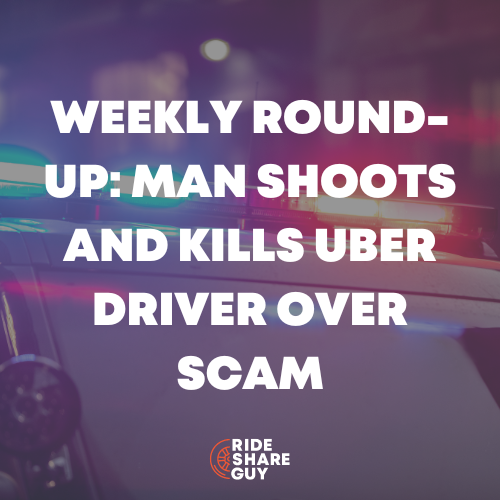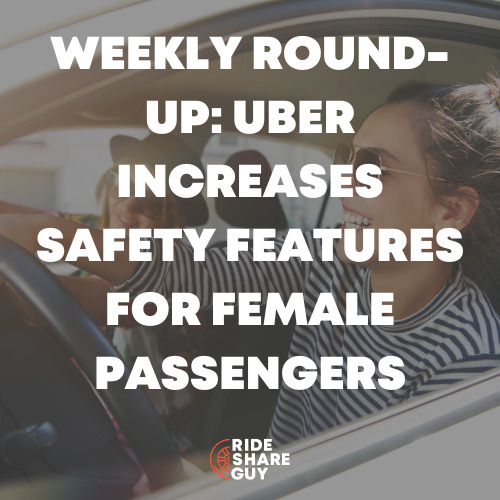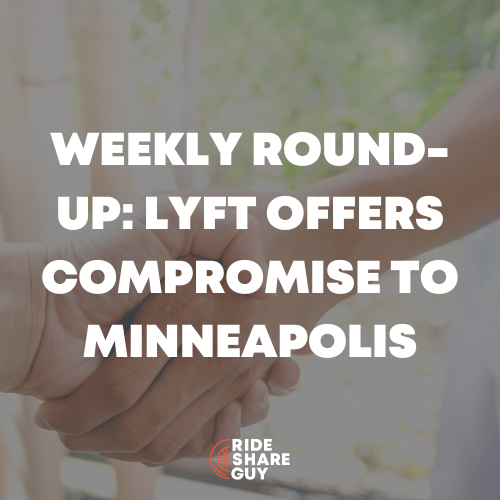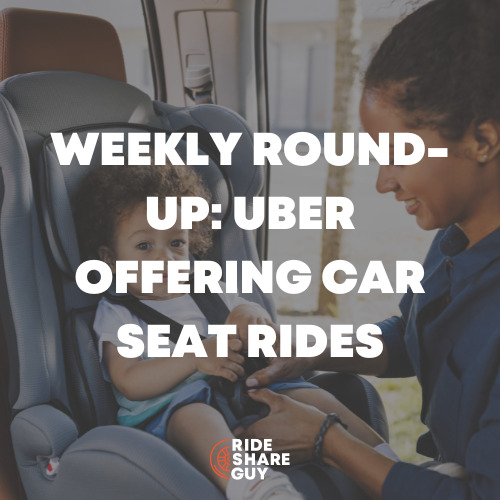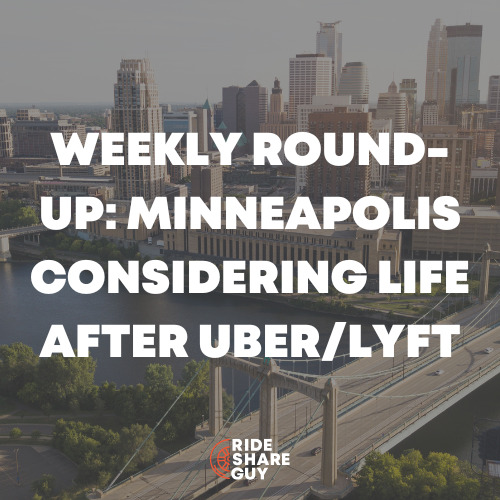Harry here. The big news from this past week came in Friday night and unfortunately it wasn’t good for drivers. Uber cut fares in 100 cities in order to ‘increase passenger demand.’ You can read more about that story here.
In the mean time, RSG contributor John Ince takes a look at Lyft’s latest partnership with GM, self-driving cars vs rideshare drivers and some issues with transporting minors.
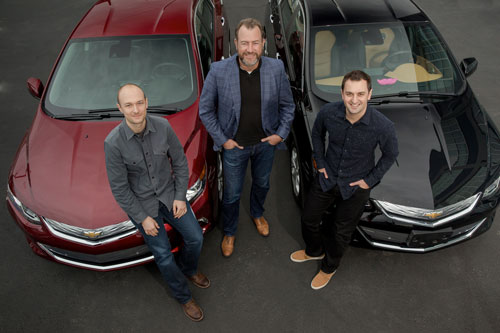
GM Invests $500 Million in Lyft
Sum and Substance: General Motors Co. will invest $500 million in Lyft Inc., giving the ride-hailing startup a valuation of $5.5 billion and a major ally in the global battle against Uber Technologies Inc.
The investment, part of a $1 billion financing round for Lyft, is the biggest move by an automaker to date when it comes to grappling with the meteoric rise of the ride-hailing industry.
GM and Lyft said they will work together to develop a network of self-driving cars that riders can call up on-demand, a vision of the future shared by the likes of Uber Chief Executive Officer Travis Kalanick and Google-parent Alphabet Inc. More immediately, America’s largest automaker will offer Lyft drivers vehicles for short-term rent through various hubs in U.S. cities, the companies said in separate statements on Monday.
GM President Dan Ammann, who is joining Lyft’s board as part of the deal, expects the automotive industry to “change more in the next five years than it has in the last 50 and we obviously want to make sure we’re at the forefront of that change.”
My Take: This is a significant development for several reasons. First, it almost doubles Lyft’s valuation to $5.5 billion. Second, it puts over a billion of cash in their corporate coffers and gives them more time to compete aggressively on price and recruiting with Uber. Third, it distinguishes Lyft from Uber in the area of building alliances.
Rather than going head to head with Uber, Lyft now has global partnerships in China, India and Detroit that significantly strengthen its competitive position. Fourth, it signals that Lyft too is thinking ahead towards driverless cars and a world in which ridesharing starts to diminish the ubiquity of car ownership (see below for more on this issue). Finally, it potentially opens up another option for drivers who want to lease their car. All are positives for Lyft and negatives for Uber.
Kids’ safety shapes background checks for Uber, Lyft drivers
Sum and Substance: California regulators are taking a hard look at whether kids should be able to ride alone in “rideshares” like Uber or Lyft — a decision that could tighten restrictions for drivers.
Those potential new rules come as the California Public Utilities Commission considers new criminal background check requirements for child-focused “rideshare” services like Shuddle, or HopSkipDrive, which the San Francisco Examiner previously reported.
Though commonly called “rideshares,” Uber and Lyft are legally called Transportation Network Companies by California regulators, or TNCs. Lyft users are required to be at least age 18, the company’s attorneys wrote to the CPUC, adding “… it is Lyft’s policy that unaccompanied minors are not permitted to take Lyft rides on their own.” Uber similarly requires account holders to be 18, according to the company’s Terms of Service Agreement. But San Francisco’s Taxi Workers Alliance and the Greater California Livery Association both argued Uber and Lyft should have deeper criminal background checks.
My Take: This is an issue of real concern to me because I’d say almost 20% of my riders in Marin County are underage – most are high school students. To my knowledge, neither Uber nor Lyft have ever made any attempt to educate their passengers about this, and why would they? On the contrary, it is now just assumed that most parents in Marin want their kids to have an Uber/Lyft account because they believe it’s the responsible thing to do to protect their kids from a possible DUI or accident. But it puts us drivers in a very awkward/uncomfortable position.
Related Article: Are Uber Drivers Allowed To Transport Minors?
What are we supposed to do when we arrive after a 10 minute drive to discover the passenger is underage? Do we refuse the ride? Do we forfeit the fare and leave a passenger stranded or take them despite personal risks? Do we give the ride but tell the passenger what they’re doing is against company policy? Would most drivers risk a low rating for an empty gesture that probably won’t change anything? Do we keep our mouths shut and simply go along with a practice that skirts the law? Probably.
On occasion, what I’ll do is intentionally give the underage passenger a very low rating to alert other drivers to this passenger. But more often than not, the underage passenger is so pleasant that I don’t have the heart to do that. What do you think?
Lyft Driver Killed in New Year’s Day Crash
Sum and Substance: A 21-year-old Lyft driver was killed in a suspected DUI crash in Hawthorne on New Year’s Day, Hawthorne police confirmed.
“I’m just kind of not ready to let him go,” Ronald Anderson, father of Thor, said as he wiped away tears. “Just seems almost unreal that he’s gone.” The father of a Lyft driver said his son was working to bring in money for the family when he was killed in a New Year’s Day crash. Before the crash, Thor told his father he was excited to work New Year’s Eve because he would make a lot of money.
Ronald said Thor would help the family by working for Lyft. “He said, ‘I’m happy doing what I’m doing,'” Ronald said. Thor’s father also said that because he would be making a lot of money driving for Lyft that evening, he and Ronald should meet up for breakfast.
My Take: Not a good way to start the New Year! Beyond the personal tragedy here, it’s also a PR nightmare for Lyft. Here they’re presenting themselves as the friendly, but funky guys with pink mustaches – helping to keep everyone safe by taking drunk drivers off the road and BAM. Suddenly they’re broadsided by a story that calls into question the safety of being a driver.
I’d really like to see Uber and Lyft’s statistics on how many of their drivers are in car accidents. I’m guessing that there’s a really good reason they never release this data. Let’s face it, driving a taxi – or a rideshare vehicle – has to be one of the most dangerous occupations going. Fortunately we all rake in the big bucks that compensate us for the personal risks we’re taking… yeah right.
A look inside the insanely successful life of billionaire Uber CEO Travis Kalanick
Sum and Substance: Five years ago, Travis Kalanick launched a startup called UberCab in San Francisco. Fast forward a few years and Kalanick’s company, now just called Uber, is now one of the most lucrative in Silicon Valley.
Uber operates in more than 300 cities in 58 countries, and it could be worth as much as $60 billion. Thanks to that sky-high valuation, Kalanick made Forbes’ list of the world’s billionaires this year, where the 39-year-old serial entrepreneur is said to have a net worth of about $6 billion.
Uber CEO Travis Kalanick grew up in Northridge, California, a suburb outside Los Angeles. When he was a kid, he wanted to be a spy.
My Take: This is one of Business Insider’s fluff pieces, mostly pictures and short blurbs, but it does have some interesting tidbits about the Uber CEO. Did you know that he’s now worth over $6 billion on paper, and during his first startup he collected unemployment in lieu of paying himself a salary. He later declared bankruptcy when another startup of his was sued for $250 million. Does this sound like the kind of guy that inspires you to do your job above and beyond the call of duty? I don’t think so.
Uber, Lyft drivers know they will be replaced by self-driving cars
Sum and Substance: Lyft announced Monday that it has partnered with automotive giant General Motors to create a network of self-driving cars that will one day in the distant (or not-too-distant future) be able to pick up and drop off passengers at the touch of a button on our phones — and likely put many of its drivers out of work.
“It makes me feel like they don’t care about the people who work for them on the road, which is surprising when it comes to Lyft,” Lara says. After digesting the news, she’s feeling more “undecided” about continuing to work with the company.
Lara’s concerns highlight the delicate balance that Lyft, which calls itself the “friendly” ride-hailing company, and its billion-dollar competitors must strike as they simultaneously tout their innovative plans for the future — a future that may not involve drivers — while courting the thousands and thousands of drivers needed to work with them now.
Uber, the leader in the ride-hailing market, publicly stated in 2014 that it intends to replace drivers with autonomous vehicles down the road. Yet Uber has been mostly quiet about these efforts since then, making it easier for drivers to ignore the writing on the wall. Now, with Lyft following suit, trumpeting a major industry partner and even a very official sounding name for the driverless program (The Autonomous On-Demand Network), it suddenly feels more like a reality drivers need to confront.
My Take: Personally, my time horizon with Uber and Lyft isn’t long enough to see this ever being an issue that concerns me. We are talking years perhaps decades before Uber, Lyft, GM, Google and others have worked out all the details that have to be in place before this becomes a reality. Beyond the technology development, there will need to be new laws on insurance, lane closures, safety and a whole host of issues before we’ll see this.
But both Uber and Lyft want to be perceived as technology companies because it gives them cache (and higher valuations) with investors. Hence moves like this meeting their need to be seen as tech friendly and savvy – especially when it comes to a potential revolution like driverless cars.
Drivers, what do you think about the week’s top stories?
-John @ RSG
